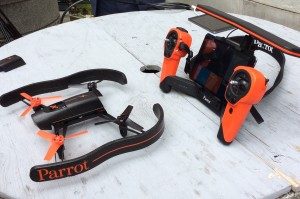
Parrot, manufactures of the iconic AR.Drone, announced on Monday their latest drone to hit the market, the Bebop. The new drone, which looks similar to (if slightly smaller than) the AR.Drone models, is a quad-copter with a built in camera that features removable styrofoam propellor guards. But that is where the similarities to Parrot’s previous drones end.
The Bebop features a 14 mega-pixel, 1080p HD, fisheye camera that works in tandem with a new image stabilization algorithm. The result is an extremely smooth image capture that looks like it was shot with an expensive 3-axis gimbal. There is no shaky camera or image distortion caused by turbulence or uneven controls.
And speaking of controls, the Bebop can be piloted using the new FreeFlight 3.0 application for iOS and Android as is the case with all previous Parrot drones. However, for the first time, Parrot is introducing a physical control station add-on known as the Skycontroller. The new hardware is an optional part of the Bebop package and features joystick controls and a dock for your tablet so you can see what your drone sees in real time.
If the tablet view isn’t immersive enough for you, the Skycontroller is compatible First Person View devices.

Translation? The ability to integrate your Bebop with an Oculus Rift Virtual Reality headset is now a standard feature.
Parrot CEO Henri Seydoux said Oculus integration was a capability he wanted to include since the beginning of the drone’s development. “For me, I wanted to fly with the birds,” he said.
In addition to VR integration, the Skycontroller also boasts amplified Wi-Fi radio and four antennas which, in conjunction with the Bebops four built-in Wi-Fi chips, can boost the drone’s range up to 2 kms. If the drone flies out of Wi-Fi range, it simply returns home.
However, the drone can fly far beyond this range because, for the first time, Parrot built a GPS system into the drone’s hardware. Pilots can now set waypoints for a pre-determined flight plan and the Bebop will fly autonomously. At any point, the pilot can hit the new ‘return home’ button and the Bebop will return to its point of origin.
So, in reality, the drone can fly as far as its (approximately) 12 minutes of battery life will allow.

“Drones are not just video games or toys anymore. So we built the Bebop with everybody,” said Seydoux. And he is right. The Bebop is Parrot’s first drone that can truly be described as a tool as much as it is a toy. Seydoux envisions professionals in architecture, real estate and the film industry will find the Bebop useful.
Parrot also stepped up their safety features for their new drone. If someone happens to touch a propellor (which stings and will leave a mark but cause no serious damage) all of the propellers shut down and the drone lands.
“Safety is something we really worked on,” said Seydoux. Nevertheless, “you should keep it [the Bebop] in line of sight. You should know the regulations where you are flying.”
The release date for the Bebop has not yet been announced. Nor has the eventual price point, but we imagine it will probably fall between $500-$1000.
Alan is serial entrepreneur, active angel investor, and a drone enthusiast. He co-founded DRONELIFE.com to address the emerging commercial market for drones and drone technology. Prior to DRONELIFE.com, Alan co-founded Where.com, ThinkingScreen Media, and Nurse.com. Recently, Alan has co-founded Crowditz.com, a leader in Equity Crowdfunding Data, Analytics, and Insights. Alan can be reached at alan(at)dronelife.com







Hello,
is it able to follow ? like the 3DR IRIs ?
Not out of the box, but its probably only a matter of time considering how popular this feature is becoming: https://dronelife.com/2014/06/25/drone-kickstarters-watch/